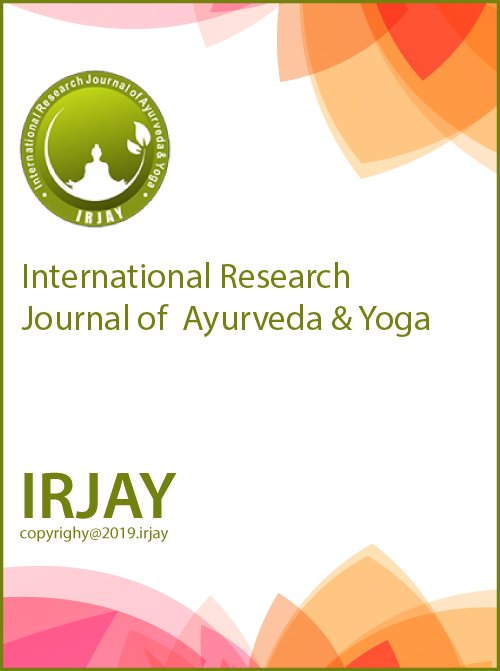Review on Vishajanya Janapadodwamsa Vyadhi w.s.r. to Environmental Toxicity
DOI:
https://doi.org/10.48165/IRJAY.2024.71206Keywords:
Environment, toxicity, hazards, purification, COVID-19Abstract
Environmental toxicology is a multidisciplinary domain of science, which occupies an important niche, overlapping the field of toxicology. It focuses on humans and other living beings and therefore plays an important role in addressing public health challenges. With increasing numbers of environmental problems, there is a need for immediate health solutions. Environmental toxicity and its health hazards are not a new global issue; it has been in practice for 5,000 years. In olden days, kings, when they entered enemy kingdoms along with the military, faced the threat of being poisoned by entities like air, water, land, grass, and cattle feed. In present days, because of human activities, industries, pesticides, chemicals, and other unhealthy behaviors, the environment is getting poisoned and affecting the health of not only human beings but also the other living creatures of the earth and aquatic ecosystems. The present COVID-19 crisis is also a kind of environmental toxicity affecting the whole world. This paper is an attempt to review the health problems and methods of purification of such environmental particulates explained in classical texts and discuss the adaptation of these methods for challenging problems related to environmental toxicity in the present era.
Downloads
References
Park, K. (2009). Park’s textbook of preventive and social medicine (20th ed., p. 641). M/s Banarsidas Bhanot, Jabalpur, India.
Murthy, K. R. S. (2010). Sushruta Samhita, Sutrasthana (4th ed., p. 430). Chaukhambha Orientalia, Varanasi, India. 3. Murthy, K. R. S. (2010). Sushruta Samhita, Nidanasthana (4th ed., p. 251). Chaukhambha Orientalia, Varanasi, India. 4. Tripathi, B. (2013). Charak Samhita (6th ed., p. 677). Chaukhambha Subharti Prakashan, Varanasi, India. 5. Tripathi, B. (2013). Charak Samhita (6th ed., p. 677). Chaukhambha Subharti Prakashan, Varanasi, India. 6. Murthy, K. R. S. (2010). Sushruta Samhita, Viman Sthan (4th ed., p. 430). Chaukhambha Orientalia, Varanasi, India. 7. Murthy, K. R. S. (2016). Astanga Samgraha of Vagbhatta, Sutrasthana (4th ed., p. 86). Chaukhambha Orientalia, Varanasi, India.
Murthy, K. R. S. (2010). Sushruta Samhita, Kalpasthana (4th ed., p. 430). Chaukhambha Orientalia, Varanasi, India. 9. Murthy, K. R. S. (2010). Sushruta Samhita, Sutrasthana (4th ed., pp. 326–328). Chaukhambha Orientalia, Varanasi, India. 10. Murthy, K. R. S. (2012). Astanga Samgraha of Vagbhatta, Sutrasthana (5th ed., pp. 86–92). Chaukhambha Orientalia, Varanasi, India.
Tripathi, B. (2013). Charak Samhita, Kalpasthana (4th ed., p. 677). Chaukhambha Subharti Prakashan, Varanasi, India. 12. Murthy, K. R. S. (2010). Sushruta Samhita, Kalpasthana (4th
ed., p. 431). Chaukhambha Orientalia, Varanasi, India. 13. Murthy, K. R. S. (2010). Sushruta Samhita, Kalpasthana (4th ed., p. 432). Chaukhambha Orientalia, Varanasi, India. 14. Tripathi, B. (2013). Charak Samhita, Kalpasthana (4th ed., p. 677). Chaukhambha Subharti Prakashan, Varanasi, India. 15. Murthy, K. R. S. (2010). Sushruta Samhita, Kalpasthana (4th ed., p. 430). Chaukhambha Orientalia, Varanasi, India. 16. Murthy, K. R. S. (2010). Sushruta Samhita, Kalpasthana (4th ed., p. 432). Chaukhambha Orientalia, Varanasi, India. 17. Murthy, K. R. S. (2010). Sushruta Samhita, Kalpasthana (4th ed., p. 434). Chaukhambha Orientalia, Varanasi, India. 18. Murthy, K. R. S. (2010). Sushruta Samhita, Kalpasthana (4th ed., p. 433). Chaukhambha Orientalia, Varanasi, India. 19. Tripathi, B. (2013). Charak Samhita, Kalpasthana (4th ed., p. 679). Chaukhambha Subharti Prakashan, Varanasi, India. 20. Sharma, A. (2013). Textbook of Agadtantra (1st ed., p. 49). Chaukhambha Orientalia, Varanasi, India.
Park, K. (2009). Park’s textbook of preventive and social medicine (20th ed., p. 641). M/s Banarsidas Bhanot, Jabalpur, India.
Park, K. (2009). Park’s textbook of preventive and social medicine (20th ed., p. 645). M/s Banarsidas Bhanot, Jabalpur, India.
Nautiyal, C. S., Chauhan, P. S., & Nene, Y. L. (2007). Medicinal smoke reduces airborne bacteria. Journal of Ethnopharmacology, 114(3), 446–451.
Sharma, P. K., Ayub, S., Tripathi, C. N., & Dubey, S. K. (2014). Agnihotra – A non-conventional solution to air pollution.
International Journal of Innovative Research in Science & Engineering, 2(98), 90.
Pal, A. A., Shrikantha, P. H., Chandra, N., & Rao, P. (2015). Experimental study of Shushrutokta Jalaprsadana vidhi WSR to Gomeda. Journal of Ayurveda & Holistic Medicine, 3(4), 42–52.
Kalasannavar, S. B., Hiremath, S. K., & Hamoannavar, U. S. (2018). An experimental study on the efficacy of Vangbhatokta Jala Nirvishikarana Yoga on polluted water. International Journal of Ayurveda and Pharma Research, 6(12), 26–33.
Khajanchi, L., Minhas, P. S., Shipra, Chaturvedi, R. K., & Yadav, R. K. (2008). Extraction of cadmium and tolerance of three annual cut flowers on Cd-contaminated soils. Bioresource Technology, 99(8), 1006–1011.

